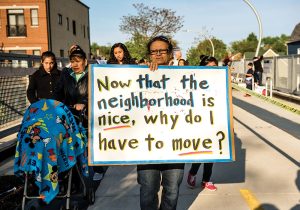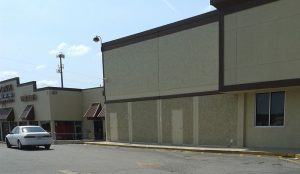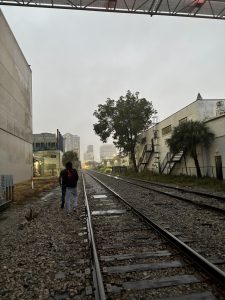Rebecca Romulus
Gentrification: Shifting families & Neighborhoods

Gentrification is the process in which a low income area encounters a massive influx of middle class or wealthy people. The of arrival these people results in renovations such as newer homes and businesses within the neighborhood. On the surface, the process of gentrification seems beneficial as it provides the people living in low income areas with a better environment. However, if you dig deeper you can see that gentrification alters the financial and cultural aspect of the initial neighborhood.
At first, I had little to no understanding of gentrification and how it affects a community. However, As I became more involved in my research, I realized that gentrification is as ongoing problem in communities around the United States including mine. This then caused me to dig deeper into the history of this process and how to identify whether or not a community is suffering from the impact of what it causes.
My participant’s name is Christy Romulus, age 28 she is my step sister. I asked her to take part in this research because she has lived in a low income area in Orlando, Florida that she watched suffer from gentrification. I knew that her personal experience would be resourceful first-hand information that will further this research. Additionally, it will give me personal insight on the shift families, such as hers, encountered due to the influx of middle class and wealthy people. Her assignment was to take three pictures that represent community, culture, and urban development. She was also asked to write at least of paragraph about why she took each picture and what it means to her. This photo voice will show the reality of gentrification from the perspective of a low income family.

Christy Romulus’s Statement
“This shopping center was not always what it seems. In the image captured the shopping center looks fairly dead. Like a ghost town almost. Not many people going in and out the stores. That’s not always how it was. Several years back, this shopping center was occupied by a grocery store name Albertsons. My mom use to take us there every other Saturday to go grocery shopping for Sunday dinner. It would always be busy on weekends so we had to wake up early Saturday morning to beat the crowd. As more suburban areas developed, people began to move causing the busyness of the shopping center to decrease. More and more people moved causing the community to be neglected. Eventually Albertsons went out of business because profit became very slow. As more people moved, the community became neglected. We no longer had access to an affordable near by grocery store. It nearly became a ghost town.”
Analysis
Gentrification hurts the communities that are left behind. It can be interpreted from the image above that the development of more suburban areas caused a major shift in the environment. An area that was once occupied by a thriving businesses that attracted many people became less populated which negatively affect businesses and the people within the community who relied on the businesses. This forced people to more resourceful urban areas. Those who couldn’t afford to move were left behind and forced to live an environment that was no longer being nurtured.

Christy’s statement
“This image captures volunteers working at the communities garden. There are so many different spices and herbs planted from different cultures that provides nutrients for the community. The amount of homeless people in the neighborhood is rapidly increasing. Unfortunately, these homeless people don’t have the luxury of eating meals on a daily basis. Fortunately, the garden captured above works as a way to grow natural resources to feed a community of people. This garden has been a gem to the community for years. There has been recent controversy surrounding the continuation of the garden. The space that the garden takes up potentially up for sale. There have been rumors of developers wanting to buy the property to build a Starbucks.
Analysis
Urban development often occurs in low income areas. A Starbucks might benefit the appeal to the neighborhood. It will attract more people and more businesses. However, it does not benefit the people living in the neighborhood who can’t even afford Starbucks. Additionally, the potential development of this building not only destroys the garden but negatively effects the homeless people who relied on the garden to eat. Ms.Romulus along with other members of the community value the rich culture and sense of community that derives from the neighborhood garden. The potential for large profits tears apart living spaces shifting the community of people who relied on those spaces.

Christy’s statement
” A few friends and I we exploring the city late afternoon. You can see super tall beautiful building in a distance. Some are still in the process of being built but for the most part, the rest of the are fully developed. Can you believe that those buildings are a few blocks from my neighborhood? When I was a kid nun of that was there. If I went a few blocks from my neighborhood I use to see a few houses, corner stores, small businesses, and unoccupied land. Now there’s a city that never sleeps. According to an article titled Examining the Negative Impacts of Gentrification published Georgetown Law, ” Because of the potential for large profits from the conversion of ordinary living spaces to high-rise or office buildings, unscrupulous landlords have used immoral means to intentionally displace low-income residents from rent-controlled areas.” It makes me think that a few years from now, my neighborhood will be consumed by the city. I mean that’s what happened to the space and people that were there before and now they are gone.
Analysis
Gentrification has the power to change neighborhoods into cities and or high-end areas. As stated by Ms. Romulus, a few blocks from the city of Downtown Orlando are several low income areas. Many of which are being bought and sold to companies to build more high rise buildings and profitable businesses.
Although the city may be beautiful are resourceful for the people who find jobs, high rise apartments, and business owners looking for space, it increases the cost of living in the area. This forces the people who lived there before to either keep up with the new and much more prices brought to the area or move. In most cases, people are forced to move because they can no longer afford to live in a home that they owned for years.
THEME
Ms. Romulus has witnessed gentrification first-hand within her community. This is an ongoing problem for Ms.Romulus and thousands of low-income communities across the United States. The participant is passionate about her community and keeping it together despite the development occurring around her. The images she provided have an underlying theme of a community that is suffering from the negative impacts of gentrification. The research conducted is similar to the art and architecture of Chicano Park. Just as Lauren Walser described, the park represents a community of people who remained displaying their culture and influences. Surrounding this park is a the city of San Diego which can be interpreted as gentrification. A new city was formed while an aspect of Chicano Park represents the community that remained,
To this day, gentrification is rapidly increasing shifting families and neighborhoods forcing them to relocate due to being unable to keep up with the new cost of living.
Works Cited
- law.georgetown.edu
- The Murals of San Diego’s Chicano Park
https://savingplaces.org/stories/explore-the-murals-of-san-diegos-chicano-park#.XaoUH-hKhnJ
- https://albertsonsfloridablog.blogspot.com/2018/03/former-albertsons-4310-orlando-fl-pine.html
Media Attributions
- gentrification © Pete Saunders is licensed under a Public Domain license
- gen 4 © Jon Springer is licensed under a Public Domain license
- Community garden
- IMG_0176 © Christy Romulus is licensed under a Public Domain license

